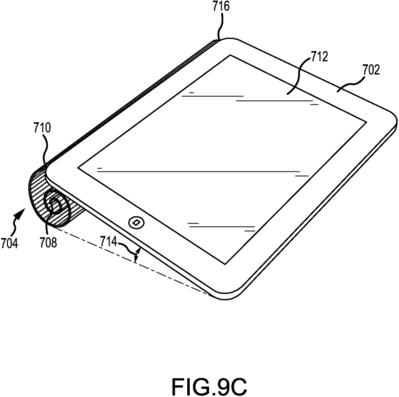
The aluminum unibody construction that Apple uses for its MacBooks is approaching its fifth birthday, and while it still makes for very sturdy and attractive-looking laptops, it's getting a bit long in the tooth. Older designs like the 2013 MacBook Air have us wondering how Apple can continue to make its products lighter and thinner without sacrificing the build quality the company is known for. A new patent application published today may just point the way forward.
The patent in question (application number 20130216740) is for "interlocking flexible segments formed from a rigid material," and it describes a process by which "a substantially rigid" piece of material—including but not limited to plastic or metal—can be cut in a geometric pattern to make it bendable. Either a laser or "electrical discharge machining" can be used to make the cuts. The degree to which the "hinge" can be bent is "defined by the geometric pattern," indicating that slightly different cuts could result in more or less bendable hinges. By using these specially cut pieces of material rather than traditional hinges, one could theoretically reduce both the thickness and the manufacturing cost of your device (at least, so says the patent).
Several photos included with the patent indicate potential uses for the technology—the first (and most interesting) would be in laptops, where the separate lid, bottom case, and hinge pieces could be completely replaced by a single strategically cut piece of material.


Replacing the traditional hinge could be particularly useful in the MacBook Airs, where the hinge contributes significantly to the thickness of the laptop—the current model is 0.68 inches thick in the back where the hinge is, but only 0.11 inches thick at the front. Other pictured uses of the technology include flexible headphones and a variant on Apple's Smart Cover for the iPad and iPad mini. The new cover would work mostly like the old one but would be much more malleable.


Apple closes by saying that these are simply examples of how the technology could be used:
For example, while examples disclosed herein may focus on enclosures, it should be appreciated that the concepts disclosed herein may equally apply to substantially any other components constructed out of rigid materials, such as, but not limited to, garage doors, coverings for architectural openings (e.g., blinds or shades), bands for supporting an electronic device around a portion of a user, and so on. [...] Accordingly, the discussion of any embodiment is meant only to be exemplary and is not intended to suggest that the scope of the disclosure, including the claims, is limited to these examples.
It's worth noting that Apple patents plenty of things, and not all of them show up in actual shipping products. That said, the procedures outlined in this patent could make several of Apple's products thinner, lighter, and less complex, and we wouldn't be surprised to see it in next-generation Smart Covers or MacBooks at some point in the future. Patently Apple summarizes the patent in relatively clear, simple language, but for those of you who don't mind wading through patent language, the full patent application (along with all of its text and images) can be found here.
Listing image by Apple
reader comments
117